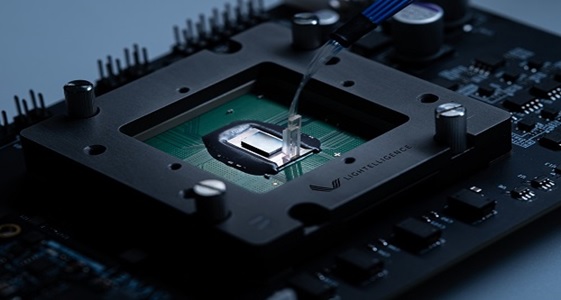Optical Chip That Can Efficiently Solve Complex AI Problems
Optical computing startup Lightelligence has demonstrated a silicon photonics accelerator running the Ising problem more than 100 times faster than a typical GPU setup.
Lightelligence’s photonic arithmetic computing engine, known as Pace, is an integrated optical computing system consisting of about 12,000 photonic devices running at 1 GHz. That represents about a 1million-fold speedup versus Lightelligence’s 100-device prototype, Comet, unveiled in 2019. The latest demonstration also marks the first time Lightelligence showed use cases beyond AI acceleration on its hardware. [1]

Figure 1. Optical Chip That Can Efficiently Solve Complex AI Problems
Figure 1 shows pace can run algorithms from the NP-Complete class of problems, which are computationally extremely difficult, many times faster than existing accelerators. While not demonstrating optical superiority for all applications, it did execute the Ising problem 100 times faster than a typical GPU, even beating a system purpose-built for the Ising problem–Toshiba’s simulated bifurcation machine, which runs on FPGAs–by a factor of 25. [3]
Something that Requires More Effort
To obtain high-quality results, a large number of circuit design, simulation, iteration, and test chips are needed. Large-scale chip manufacturing is another challenge.
"We are using two chips based on different manufacturing processes and stacking them directly, with thousands of connections between them," said Maurice Steinman, vice president of engineering at Lightelligence.
"One is driven by light, so we need to install a light source there. The other needs electricity to power and dissipate heat. We have to attack systematically to put it all together, which is a huge challenge, "he added." [4]
Future Outlook
Much of the intensive AI compute happens in the cloud at data centres that require large processing capabilities. With the new optical chips, the many servers employed will consume much less electricity and subsequently burn much less power.
With this new technology, the advancing computational challenges of the future can be quickly and efficiently tackled. Autonomous vehicles are another feature that will heavily rely on AI for making quick decisions. Faster computational imaging leads to faster decision-making.
“Our chip completes these decision-making tasks at a fraction of the time of regular chips, which would enable the AI system within the car to make much quicker decisions and more precise decisions, enabling safer driving,” says Yichen Shen. “We believe optics is going to be the next computing platform, at least for linear operations like AI,” adds Shen. PACE accelerator chip will begin to be shipped in 2022. [2]
References:
- https://www.eetimes.com/optical-computing-chip-runs-hardest-math-problems-100x-faster-than-gpus/#
- https://www.electronicsforu.com/news/whats-new/optical-chip-efficiently-solve-complex-ai-problems
- https://www.i-micronews.com/optical-chip-solves-hardest-math-problems-faster-than-gpus/
- https://www.easybom.com/blog/a/optical-chips-that-can-efficiently-solve-complex-artificial-intelligence-problems
Cite this article:
Thanusri swetha J (2022), Optical Chip That Can Efficiently Solve Complex AI Problems, pp. 85

